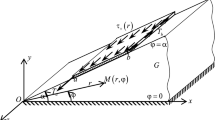Abstract
Periodic contact problems for a three-dimensional elastic wedge (a dihedral angle, a half-space and a quarter of space are particular cases), taking into account the Coulomb friction forces in unknown contact areas are considered. One face of the wedge is rigidly fixed, and the other face interacts with an infinite rectilinear chain of identical rigid dies, the axis of the chain is parallel to the edge of the wedge. Friction forces perpendicular or parallel to the edge of the wedge are taken into account. Integral equations are derived in which the series generated by the Cerruti components of the contribution of friction forces are summed exactly. Problems are solved using the method of nonlinear integral equations, which makes it possible to simultaneously determine the contact area and contact pressures. The mechanical characteristics are calculated, the transition from a discrete to a continuous contact area of infinite length is studied.



Similar content being viewed by others
REFERENCES
Y. Xu and R. L. Jackson, “Periodic contact problems in plane elasticity: the fracture mechanics approach,” ASME J. Trib. 140 (1), 011404 (2018). https://doi.org/10.1115/1.4036920
D. A. Pozharskii, “Periodic contact and mixed problems of the elasticity theory (review),” Izv. Vuzov Sev.-Kav. Reg. Estest. Nauki, No. 2, 22–33 (2021). https://doi.org/10.18522/1026-2237-2021-2-22-33
I. G. Goryacheva, “The periodic contact problem for an elastic half-space,” J. Appl. Math. Mech. 62 (6), 959–966 (1998). https://doi.org/10.1016/S0021-8928(98)00122-1
I. G. Goryacheva, Mechanics of Frictional Interaction (Nauka, Moscow, 2001) [in Russian].
A. Yakovenko and I. Goryacheva, “The periodic contact problem for spherical indenters and viscoelastic half-space,” Tribol. Int. 161, 107078 (2021). https://doi.org/10.1016/j.triboint.2021.107078
V. M. Aleksandrov, “Doubly periodic contact problems for an elastic layer,” J. Appl. Math. Mech. 66 (2), 297–305 (2002). https://doi.org/10.1016/S0021-8928(02)00036-9
V. A. Yastrebov, G. Anciaux, and J.-F. Molinari, “The contact of elastic regular wavy surfaces revisited,” Tribol. Lett. 56, 171–183 (2014). https://doi.org/10.1007/s11249-014-0395-z
N. B. Zolotov and D. A. Pozharskii, “Periodic contact problems for a half-space with a partially fixed boundary,” Mech. Solids 57, 1758–1765 (2022). https://doi.org/10.3103/S0025654422070202
I. G. Goryacheva and E. V. Torskaya, “Modeling of fatigue wear of a two-layered elastic half-space in contact with periodic system of indenters,” Wear 268 (11–12), 1417–1422 (2010). https://doi.org/10.1016/j.wear.2010.02.018
I. A. Soldatenkov, “The periodic contact problem of the plane theory of elasticity. Taking friction, wear and adhesion into account,” J. Appl. Math. Mech. 77 (2), 245–255 (2013). https://doi.org/10.1016/j.jappmathmech.2013.07.017
I. A. Soldatenkov, “The spatial contact problem for an elastic layer and wavy punch when there is friction and wear,” J. Appl. Math. Mech. 78 (1), 99–106 (2014). https://doi.org/10.1016/j.jappmathmech.2014.05.011
I. G. Goryacheva and Y. Makhovskaya, “Combined effect of surface microgeometry and adhesion in normal and sliding contacts of elastic bodies,” Friction 5, 339–350 (2017). https://doi.org/10.1007/s40544-017-0179-1
D. A. Pozharskii, “Periodic contact problem for an elastic wedge,” J. Appl. Math. Mech. 79 (6), 604–610 (2015). https://doi.org/10.1016/j.jappmathmech.2016.04.007
B. A. Galanov, “The method of boundary equations of the hammerstein-type for contact problems of the theory of elasticity when the regions of contact are not known,” 49 (5), 634–640 (1985). https://doi.org/10.1016/0021-8928(85)90084-X
D. A. Pozharskii, Fundamental Solutions of Elastic Wedge Statics and Applications (DGTU-Print, Rostov-on-Don, 2019) [in Russian].
D. A. Pozharskii, “The three-dimensional contact problem with friction for an elastic wedge,” J. Appl. Math. Mech. 72 (5), 619–625 (2008). https://doi.org/10.1016/j.jappmathmech.2008.11.001
I. M. Gel’fand and G. E. Shilov, Genaralized Functions and Actions on Them (Fizmatgiz, Moscow, 1959) [in Russian].
A. P. Prudnikov, Yu. A. Brychkov, and O. I. Marichev, Integral and Series, Vol. 1: Elementary Functions (Gordon and Breach Sci. Publ., New York, 1986; Nauka, Moscow, 1981).
A. P. Prudnikov, Yu. A. Brychkov, and O. I. Marichev, Integral and Series, Vol. 2: Special Functions (Gordon and Breach Sci. Publ., New York, 1986; Nauka, Moscow, 1983).
Funding
This work was supported by the Russian Science Foundation (project no. 22-21-00013).
Author information
Authors and Affiliations
Corresponding authors
Additional information
Translated by M.K. Katuev
About this article
Cite this article
Pozharskaya, E.D., Pozharskii, D.A. & Sobol, B.V. Periodic Contact Problems for a Wedge with Friction Forces. Mech. Solids 58, 1578–1586 (2023). https://doi.org/10.3103/S0025654423700218
Received:
Revised:
Accepted:
Published:
Issue Date:
DOI: https://doi.org/10.3103/S0025654423700218



